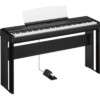About the letter designation of keys
In musical practice, a system of letter designations has long been established and is widely used, both individual sounds and tonalities. The basis is taken from the letters of the Latin alphabet, as well as some words from the same language.
To name a key, as you know, two elements are used: the name of the tonic and the name of the mode. Sometimes they even say that «TONE = TONIC + MODE». This scheme also applies to the letter designation of keys. First the tonic is called, then a word is added that should define the mode.
What letter denotes tonic?
You can read about how to call tonic water here. Let me briefly remind you that almost any sound can become a tonic – the main level or its derivative version (sharp, flat). To write musical sounds in letters, we need the first eight characters of the Latin alphabet () and suffixes (sharp) and (flat). Draw yourself a spur sign like this:
Please note exceptions to the rules (marked with an asterisk) *):
1) the B-flat note likes to show off, so it is given a separate letter, and not just any letter, but a letter – second alphabetical;
2) A and E flats are so jealous that they do not tolerate the second vowel next to them – they are written down.
RULE ONE AND LAST. If the tonality is major, then the name of the tonic is written with a capital (capital) letter, if it is minor, with a lowercase (small) letter.
How to designate a fret?
The major mode is indicated by the word (dur), and the minor mode by the word (mol). These are shortened Latin words (hard) and (soft) that have been adapted for the needs of music theory.
examples:
THAT’S NOT ALL!
I’ll tell you a fairy tale… One day, the laziest musicians came to visit Aunt Lyuba to treat themselves to Aunt Lyuba’s signature fur coat over herring. As luck would have it, the lazy musicians all became exhausted at once, and as soon as they sat down at the table, they hung their heads and dozed off. When they woke up, a bitter disappointment awaited them: some BAD MOTH had eaten the entire coat of the herring. Since then, the musicians decided that it would be easier to live without fools and prayers… Oh, it turned out to be a stupid fairy tale, sorry)))
In general, when denoting keys by letter, you don’t have to write words, as long as the RULE ONE AND LAST (see above).
Here we are a little distracted from the topic with the fairy tale, let me remind you: we were looking at the letter designation of keys. I hope you get the point. By the way, you can not only read more about the letter designation of sounds here, but also watch a cool video lesson. Here he is:
Did you like the material? Announce this to the whole world! Click “Like!” To stay up to date with new cool articles, subscribe to updates on this page in contact – http://vk.com/mus_education




